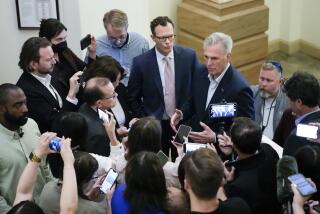S. Korean Officials, Lenders Hammering Out Details of Debt Exchange Deal
- Share via
NEW YORK — International lenders and South Korean officials on Friday were working out details of a deal to exchange up to $25 billion worth of short-term debt for new loans with longer maturities and government guarantees, banking sources said.
Negotiations, being conducted Friday in the second-floor boardroom of Citicorp’s Manhattan headquarters, were said to be in the “poker-game stage,” in which the parties dickered over interest rates, fees and other loan terms.
Attending are representatives of about 15 of the world’s largest banks, from Europe, Japan and North America, plus a delegation of South Korean government officials.
The broad outlines of the deal--that it would call for government-backed loans with maturities of one to five years--were struck in a meeting on Wednesday at Citicorp. The agreement probably will be finalized by the end of next week, bankers said.
U.S. banks, led by J.P. Morgan & Co., initially proposed a comprehensive plan that would link the debt exchange to a bond offering of $10 billion or more. However, the Korean delegation, fearing punishingly high long-term interest rates, has apparently rejected a bond offering for the time being, according to a banker involved in the talks.
Besides, South Korea’s foreign-exchange reserves have grown to about $15 billion in recent weeks--reversing the alarming outflows of November and December that threatened to drain the coffers dry, the banker said. Therefore, he added, “the urgency for new financing [through a bond offering] is no longer so great.”
The pending agreement is the third major step in a broad, private-sector effort to address South Korea’s financial crisis. Step one was a stopgap accord--slammed together between Christmas and New Year’s--in which banks temporarily pushed back the repayment deadlines for loans falling due Jan. 1. Step two, accomplished in early January, was to extend this “rollover” until the end of March.
During the resulting grace period, the parties are assembling the elements of a longer-term package intended to help restore Korea to good standing with the global lending and investment community. This is presumed to involve the pending exchange of short-term debt for one- to five-year terms, plus, at some point, step four, a bond issue to raise new long-term money.
Moody’s Investors Service and Standard & Poor’s, the two top U.S. credit-rating agencies, dropped South Korea’s bond rating to sub-investment-grade, or junk bond, status earlier this month because of the financial crisis.
Moody’s put Korean bank loans in an even lower category, ruling that the rollover was technically a default, because the banks accepted it only under duress, according to Steven Hess, Moody’s vice president and senior analyst. Although the debt exchange will be viewed as a positive development for Korean bonds, Hess noted in an interview that the bonds are currently under review for a possible further downgrade.
You Jong Keun, an economist and leader of the Korean delegation, told The Times in an interview earlier this week that the government’s goal is to obtain “single-digit” interest rates on its loans under the agreement. One banker involved in the talks said single-digit rates were likely, but a banker at a rival firm said it is strategically unwise to discuss rates while the negotiations are still in progress. “That’s part of the poker game,” he said.
More to Read
Inside the business of entertainment
The Wide Shot brings you news, analysis and insights on everything from streaming wars to production — and what it all means for the future.
You may occasionally receive promotional content from the Los Angeles Times.










